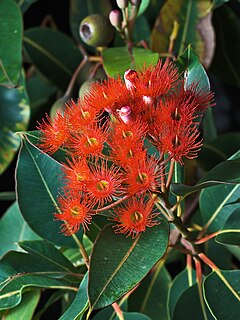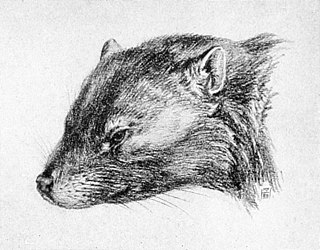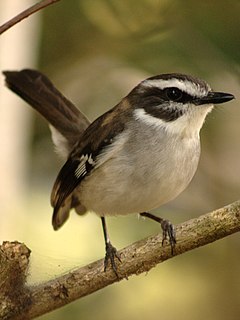
Multituberculata is an extinct taxon of rodent-like allotherian mammals that existed for approximately 166 million years, the longest fossil history of any mammal lineage. They eventually declined from the late Paleocene onwards, disappearing in the late Eocene, though they might have lived even longer into the Miocene, if gondwanatheres are part of this group. More than 200 species are known, ranging from mouse-sized to beaver-sized. These species occupied a diversity of ecological niches, ranging from burrow-dwelling to squirrel-like arborealism to jerboa-like hoppers. Multituberculates are usually placed as crown mammals outside either of the two main groups of living mammals—Theria, including placentals and marsupials, and Monotremata—but closer to Theria than to monotremes.

Rigby is a small city in and the county seat of Jefferson County, Idaho, United States. The population was 3,945 at the 2010 census, up from 2,998 in 2000.

Corymbia is a genus of about one hundred species of tree that, along with Eucalyptus, Angophora and several smaller groups, are referred to as eucalypts. Until 1990, corymbias were included in the genus Eucalyptus and there is still considerable disagreement among botanists as to whether or not separating them is valid. As at January 2020, Corymbia is an accepted name at the Australian Plant Census.

Coronaviruses are a group of related viruses that cause diseases in mammals and birds. In humans, coronaviruses cause respiratory tract infections that can be mild, such as some cases of the common cold, and others that can be lethal, such as SARS, MERS, and COVID-19. Symptoms in other species vary: in chickens, they cause an upper respiratory tract disease, while in cows and pigs they cause diarrhea. There are yet to be vaccines or antiviral drugs to prevent or treat human coronavirus infections.

The Cimolodonta are a taxon of extinct mammals that lived from the Cretaceous to the Eocene. They were some of the more derived members of the extinct order Multituberculata. They probably lived something of a rodent-like existence until their ecological niche was assumed by true rodents. The more basal multituberculates are found in a different suborder, "Plagiaulacida".
Xanclomys is a small mammal from the Paleocene of North America. It was a genus within the extinct order Multituberculata within the suborder Cimolodonta and family Neoplagiaulacidae.
Xyronomys is an extinct genus of small mammals from the Paleocene of North America, with two described species. The genus lies within the extinct order Multituberculata within the suborder Cimolodonta and family Neoplagiaulacidae.
Dorian mode or Doric mode can refer to three very different but interrelated subjects: one of the Ancient Greek harmoniai, one of the medieval musical modes, or, most commonly, one of the modern modal diatonic scales, corresponding to the white notes from D to D, or any transposition of this.

Richardoestesia is a medium-sized genus of theropod dinosaur from the late Cretaceous Period of what is now North America. It currently contains two species, R. gilmorei and R. isosceles.

Bothriospondylus is a dubious genus of neosauropod sauropod dinosaur. It lived during the Late Jurassic.
Trimerus is an extinct genus of trilobite in the family Homalonotidae. There is one described species in Trimerus, T. dekayi.

The scalloped hammerhead is a species of hammerhead shark, and part of the family Sphyrnidae. Originally known as Zygaena lewini, its genus name was later changed to its current name. The Greek word sphyrna translates into "hammer" in English, referring to the shape of this shark's head. The most distinguishing characteristic of this shark, as in all hammerheads, is the 'hammer' on its head. The shark's eyes and nostrils are at the tips of the extensions. It is a fairly large hammerhead, but is still smaller than both the great and smooth hammerheads.

Eopsaltria is a genus of small forest passerines known in Australia as the yellow robins. They belong to the Australasian robin family Petroicidae. The name is derived from the Ancient Greek for "dawn singer/song" because of their dawn chorus. They are inquisitive and bold birds, and have been reported perching on the shoulders or boots of people in the bush. Open eucalyptus woodlands are their preferred habitat. The ornithologist John Gould likened the behaviour and mannerisms of the eastern and western yellow robin to those of the European robin. The name "yellow robin" itself was applied to the eastern yellow robin by the early settlers of New South Wales.

A shrikethrush, also spelt shrike-thrush, is any one of five species of songbird that is a member of the genus Colluricincla. They have nondescript, predominantly brown or grey, plumage, but are accomplished singers, their calls described as "strong, mellow and beautiful." Shrikethrushes are generally insectivorous, though have been recorded eating molluscs and berries. They build cup-shaped nests in the forks of trees.

Poecilodryas is a genus of passerine birds in the Australasian robin family Petroicidae.
Fieldospongia is a genus of sea sponge known from the Middle Cambrian Burgess Shale. Just five specimens of Fieldospongia are known from the Greater Phyllopod bed, where they comprise less than 0.1% of the community.

Macrocheles is a genus of mites in the family Macrochelidae. There are more than 100 described species in Macrocheles.
Pachyseius is a genus of mites in the family Pachylaelapidae. There are about 13 described species in Pachyseius.
Protomonaxonida is an extinct order of sea sponges. It is a paraphyletic group gathering the most ancient species from the Burgess Shale to modern sponges.

Morum is a genus of sea snails, marine gastropod mollusks in the family Harpidae.












